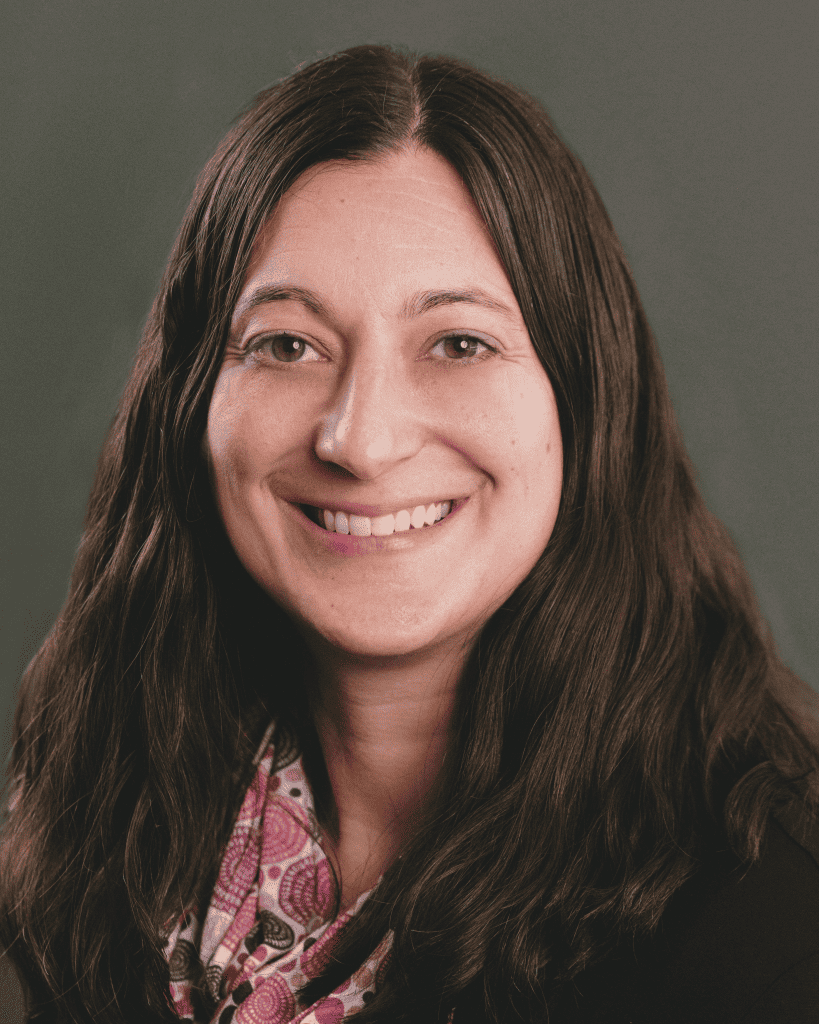VSS board members Geoff Boynton and Shin’ya Nishida will be stepping down this year. Four candidates, nominated by the membership and selected by an independent Nominating Committee, will compete in pairs for the two open positions.
Each newly elected Director will serve a four-year term on the VSS Board of Directors. Responsibilities of the Board include scheduling the Annual Meeting, implementing and monitoring VSS policies and budget, fundraising, and other VSS-related activities.
How to Vote
Log in to your MyVSS Account. In the 2025 Board of Directors Election section, click the Vote button.
You must be a current Regular or Postdoc Member to vote. Other membership types will not see the 2025 Board of Directors Election section on their account home page.
Voting closes April 24, 2025 (11:59 pm latest time zone on earth).
Candidates for Position One

Julie Golomb
The Ohio State University Website
Julie Golomb is a Professor of Psychology at the Ohio State University, where she directs the OSU Vision and Cognitive Neuroscience Lab and is head of the Cognitive Neuroscience Area and PhD program. She received her BS in Neuroscience from Brandeis University, her PhD in Neuroscience from Yale University with Marvin Chun and James Mazer, and did a postdoctoral research fellowship at MIT with Nancy Kanwisher before moving to Ohio State in 2012.
Julie’s research investigates how we achieve stable and integrated visual perception, and how perception, attention, and working memory interact. Her lab uses a variety of methodologies – including human behavior, eye-tracking, advanced fMRI and EEG methods, and computational modeling – to explore how objects and their spatial locations are perceived and coded in the brain, and how these representations are influenced by eye movements, shifts of attention, and other top-down factors. Her lab has been funded by grants and fellowships from NIH, NSF, Sloan Foundation, and NSERC.
Julie was the VSS awardee of the Federation of Associations in Behavioral and Brain Sciences (FABBS) Early Career Impact Award in 2019 and has been recognized with other awards including APA Distinguished Scientific Award for Early Career Contribution to Psychology, Sloan Research Fellow in Neuroscience, and APF Fantz Award. She is an Associate Editor at Psychonomic Bulletin & Review, and she has served on NIH and NSF study sections and various leadership committees representing Ohio State psychology, neuroscience, and cognitive science communities.
Julie is a dedicated member of the VSS community. She has attended every VSS for the past 20 years and has served on VSS Abstract Review and Young Investigator Award committees. She is passionate about mentoring and supporting the next generation of vision scientists.

Sarah Shomstein
George Washington University Website
Sarah Shomstein is a Thelma Hunt Professor of Psychological and Brain Sciences, George Washington University, Washington DC. Since 2007 she directs the Attention and Cognition Laboratory with research focused on attentional selection and cognitive control. She received a B.S. in Psychology from Carnegie Mellon University in 1998 and a Ph.D. in Psychological and Brain Sciences from The Johns Hopkins University in 2003. Sarah is originally from Kyiv, Ukraine.
Sarah’s research focuses on elucidating neural mechanisms of brain functioning pertaining to visual processing, attentional selection, and most recently venturing into multisensory perception. Research in her laboratory employs various methods that include psychophysics, neuroimaging techniques (fMRI, EEG, and TMS), eye-tracking, and neuropsychology. Employing converging methodologies has been central to her research program. Most recent advances in Sarah’s lab examine the degree to which task-irrelevant high-level knowledge (e.g., semantic relationships, real world size, affordances) goes on to influence attentional prioritization.
Work in her laboratory is supported by grants from the National Science Foundation and National Institutes of Health (NIH). Sarah is currently finishing her term as the Department Chair, a post she’s held since 2019. She is currently serving as the Editor-in-Chief of the Attention, Perception, and Psychophysics (first woman to hold this post) and at various times was an Editorial Board Member at the Psychonomic Bulletin & Review and Visual Cognition. She regularly sits on various panels and study sections at both NIH and NSF and is an ad-hoc reviewer for various international granting agencies.
Candidates for Position Two

Geoffrey Aguirre
University of Pennsylvania Website
Geoffrey Aguirre is a physician-scientist, Professor of Neurology, and Vice-Chair for Research at the University of Pennsylvania. He studies human visual perception and neural representation, with a particular focus on the effects of ophthalmologic and neurologic disease. His work combines several techniques, including functional MRI, psychophysics, and advanced stimulus spectral control.
Geoffrey completed his MD and PhD at the University of Pennsylvania under the mentorship of Mark D’Esposito, using patient studies and fMRI to identify the parahippocampal cortex as a key element of topographical representation. After residency training in Neurology, he joined the UPenn faculty in the division of Behavioral Neurology. His early independent research used adaptation and MVPA to examine the representation of faces and objects in extrastriate cortex. In parallel, he studied the effects of congenital vision loss upon the structure and function of visual cortex, and helped develop an atlas of retinotopic organization tied to cortical surface topology. More recently, he used advanced spectral control of flickering stimuli to target classes of retinal photoreceptors, including the melanopsin-containing ipRGCs, in an effort to understand the mechanistic basis of discomfort from bright and flickering light.
Although he prefers a relatively small laboratory with a close working relationship with his trainees, Geoffrey has served as the Associate Director of the UPenn Neurology residency program for a decade, is PI on training grants (a T32 and UE5), and is the co-Chair of the Burroughs-Wellcome Foundation scientific advisory committee for career development awards. In 2023 he received the Graduate Medical Education Mentorship Award from the University of Pennsylvania School of Medicine. He is the past-Chair of the NBVP (formerly SPC) NIH study section and currently serves on the Editorial Board of the NIH Director’s Transformative Research Awards. He is a Fellow of Optica and has served on the organizing committee of its Fall Vision Meeting. He is a former member of the editorial board of the Journal of Vision, and has served on the VSS abstract review committee for many years. Finally, Geoffrey is committed to responsible scientific advocacy to lay audiences. He is the Associate Director of the Center for Neuroscience and Society at UPenn, where he considers the use and misuse of brain imaging data in public communication.

Chris Baker
National Institutes of Health Website
Chris Baker is a Senior Investigator in the Laboratory of Brain and Cognition and Chief of the Section on Learning and Plasticity in the National Institute of Mental Health at NIH. Chris’s research interests focus broadly on high-level vision (faces, objects, scenes) and the role of learning and plasticity in shaping visual processing. His approach is fundamentally multidisciplinary and often cross-species, using a combination of functional magnetic resonance imaging (fMRI), magnetoencephalography (MEG), transcranial electrical/magnetic stimulation (tES/TMS), behavioral measures (psychophysics, eyetracking), and computational methods.
Chris earned his undergraduate degree in Neuroscience at the University of Cambridge and his PhD in Psychology from the University of St Andrews where he studied the neurophysiology of face and body perception with David Perrett. In postdoctoral work, he first worked with Carl Olson and Marlene Behrmann at Carnegie Mellon University, conducting studies in both human and non-human primates, before acquiring expertise in human neuroimaging with Nancy Kanwisher at MIT. In 2006, Chris joined the Laboratory of Brain and Cognition at the National Institute of Mental Health where he is now a Senior Investigator.
Chris has served as Reviewing Editor at The Journal of Neuroscience and Senior Editor at eLife, as well as editing Special Issues for Neuroimage and the Journal of Cognitive Neuroscience. He has been a regular attendee at VSS since 2002 and has organized three symposia (“How learning changes the brain”, “What has the past 20 years of neuroimaging taught us about human vision and where do we go from here?”, and “The temporal evolution of visual perception”). He received the NIH Director’s Award for Individual Contribution in 2021 and multiple awards for mentorship and for “Making a Difference”.
Current Board of Directors
The names, term-end dates, and areas of expertise are listed below. Terms end immediately after the VSS meeting of the year listed.
| Board Member | Term Ends | Expertise |
|---|---|---|
| Geoffrey Boynton | 2025 | Visual Attention, Visual Prosthetics, functional MRI, and Computational Neuroscience |
| Shin’ya Nishida | 2025 | Motion, Color and light, Multisensory processing, Object recognition |
| Anya Hurlbert | 2026 | Color and light, Object recognition, Scene perception |
| Krystel Huxlin | 2026 | Motion, Perceptual learning, Plasticity, Psychophysics, Vision loss, Visual rehabilitation, Visual restoration, Anatomy, Neurochemistry |
| Richard Krauzlis | 2027 | Attention, Pursuit, Electrophysiology in Mice and Monkeys |
| Michael Landy | 2027 | 3D perception, Binocular vision, Sensory integration, Perception and action, Texture and Spatial vision, Material perception, Psychophysics, Computational models |
| Martin Rolfs | 2027 | Saccadic Eye Movements, Motion, Attention, Awareness, Eye-tracking |
| Paola Binda | 2028 | Eye Movements and Pupillometry, functional MRI, Multisensory Processing, Visual Plasticity |
| MiYoung Kwon | 2028 | Spatial Vision, Eye Movements, Binocular Vision, Clinical Vision, Psychophysics, fMRI, and Computational Modeling |
